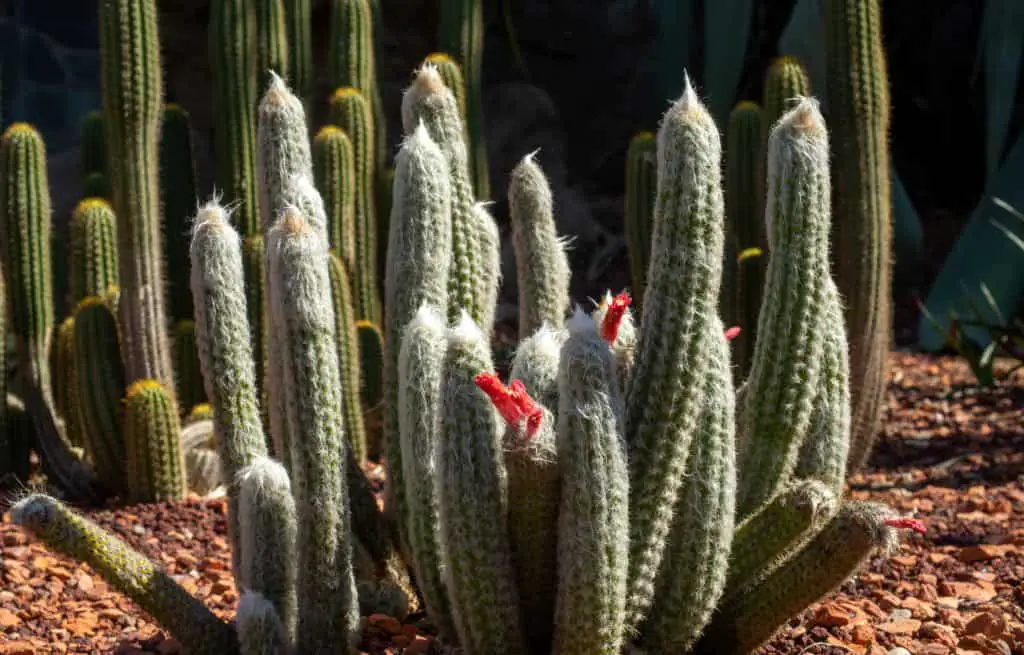The Silver Torch Cactus is a distinctive-looking cactus. It has a white woolly outside because of its fine spikes that cover the entire stem. The base of the Silver Torch Cactus is very erect and is shaped like a long cucumber. Underneath the spines on the exterior, the cactus is a grey-green color. The main stem can branch out from the base. Each new stem will grow vertically while staying attached to the mother stem.
The botanical name for a Silver Torch Cactus is Cleistocactus strausii. The name comes from the Greek word kleistos which means closed (referring to the cactus flower). Other names it is known by include Woolly Torch, Snow Pole, and Silver Torch.
Silver Torch Cactus like to grow in clusters and are known to mix in with other plants in the wild.
Silver Torch Cactus are excellent additions to the desert, rock, and succulent gardens. Some good companion plants for Silver Torch Cactus are blue chalk sticks, red aloe, artichoke agave, and Newzealand flax.
They are suitable for outdoor landscaping (as long as the temperature doesn’t drop below 15 degrees Fahrenheit) and indoor décor.
They belong to the Cactactaccae succulent family. It makes sense that their native home is in the higher elevations of Argentina, Uruguay, Peru, and Bolivia since the Silver Torch Cactus love full sunlight but is not a fan of high temperatures.
| Common Name(s) | woolly torch, snow pole, silver torch |
| Scientific Name | Cleistocactus strausii |
| Sun Exposure | Full Sun with protection from the midday sun |
| Soil pH | Not Sensitive to pH |
| Watering Requirement | Water every 2 weeks in spring and summer. Every 5 weeks in the Fall. Stop watering in the winter |
| Hardiness Zone | 9 -10 USDA |
| Plant Height | 10 Feet |
| Plant Width | 2.5 inches |

What does a Silver Torch Cactus flower look like?
Silver torch cactus flowers are slender and tubular. Typically they are three to four inches long. their color is a deep rich red or burgundy. The flowers grow horizontally from the main body of the cactus. The Silver Torch Cactus is a late bloomer and does not produce flowers until it is 10 to 15 years old. When the flowers blossom, they don’t open fully, and linger for four or five days before wilting.
When grown outdoors, the red flowers are very attractive to hummingbirds and other pollinators.
Silver Torch Cactus Adaptations
Due to living in higher elevations, Silver Torch Cactus has a deep root system. Their roots reach up to 3ft deep and can be up to 3 feet wide. This helps them stay stable in their mountain habitat and find their minimal water needs during drought.
Also, Silver Torch Cactus can store water inside its specialized stem for months to take advantage of the feast or famine weather systems. They can soak up the water during the rainy season and use it throughout the dry season.
Silver Torch Cactus Care
Silver Torch cactus is very easy to care for. As long as you have a sunny window or section of your property that can protect the Silver Torch Cactus from the full heat of mid-day, you are set to own a Silver Torch Cactus. A major thing to avoid is overwatering. It is drought resistant and very forgiving when watering is neglected.
Can you grow Silver Torch Cactus indoors?
Silver Torch Cactus is very happy planted in containers indoors. They can be potted solo or arrangements with other companion plans and pretty rocks.
Lighting
Like most cactuses, the Silver Torch Cactus likes to be in the full sun, soaking up as much light as possible. If growing inside, a south-facing window is the best place for a silver torch cactus. If it does not get enough light, it will not bloom.
A word of warning, though, although Silver Torch Cactus love the light, they do need to be protected from extreme heat.
Soil type & pH
A mixture of loam and sandy soil is the best medium for Silver Torch Cactus to grow. Loam provides nutrients and is a rich dark soil with plenty of organic matter. It also holds enough water for the cactus to thrive but does not stay too wet. When mixed with sand, this is the perfect combination. The sand is large and porous and drains exceptionally well.
Silver Torch Cactus is not a pH-sensitive plant and will grow well in acid, alkaline, or neutral soil.
Watering
Watering the Silver Torch Cactus is different depending on the season. In spring and summer, water the cactus when the top of the soil is dry. When fall comes around, have a watering schedule of every five weeks. Stop watering and let your Silver Torch Cactus dry out in the winter.
Temperature
Silver Torch Cactus prefers a normal room temperature between 68 and 72 degrees Fahrenheit in the spring, summer, and fall. It prefers a lower temperature in the winter, between 50 and 59 degrees Fahrenheit.
Even though the Silver Torch Cactus likes full sunlight, it is not keen on high temperatures.
Hardiness Zone
9 -10 USDA zones are suitable for outdoor growing of Silver Torch Cactus.
Fertilization
The fertilization requirements for a Silver Torch Cactus are not particularly strenuous. A slow-release food may be added to them in the spring. They should be repotted once a year in early spring. The fresh soil will provide nutrients for the silver torch cactus.
Propagation
Propagating a Silver Torch Cactus is a fairly simple process. Slice off a little branch near the base of the mother cactus and root it in the soil in its own container. You can tell the propagation was successful when the baby plant’s root system has been established.
This method will scar the original cactus. However, the cut will heal in about a week.
Silver Torch Cactus can be started from seed, but this is a much longer process. Plant the seeds in well-draining soil and keep them warm. If you choose this path, acquire your seed from a reputable source.
Size & Growth Rate
Silver Torch Cactus can grow up to 10 feet tall. They are slender plants, only spreading 2.5 inches wide. Their growth rate depends on how they were propagated. If a cutting was taken, they grow much faster than if they are started with a seed. Once established, they should be transplanted yearly to a larger container if being grown in a pot. Be sure to use an appropriate size vessel, If it’s too big, the soil will retain too much water, and root rot can set in and be a death sentence for your Silver Torch Cactus.
Silver Torch Cactus take 10-15 years to mature and begin flowering fully.
Life Cycle
Silver Torch Cactus is in its growth phase in early spring to late summer. They will produce flowers in mid-summer, but they only last for 4-5 days. Once temperatures start to drop, the Silver Torch Cactus will go dormant, relying on its stored reserves of water to survive the winter.
Problems, Common Pests, and Diseases
Watch your Silver Torch Cactus for spider mites and mealy bugs. If these pests invade your cactus, the easiest remedy is to use rubbing alcohol. Dip some cotton wool in the rubbing alcohol and wipe the stems thoroughly. The unwanted visitors should disappear after this.
Root rot is a really important disease to watch for with Silver Torch Cactus. It’s caused by overwatering. It can sometimes be remedied if caught early, but it is often fatal, and nothing can be done about it.
Silver Torch Cactus owners can try repotting their plant in new, clean, dry, sterile soil that is well draining.
Be sure to rinse off the roots and pat dry with a paper towel to avoid transferring any pathogens that may be present with the root rot.
Where can I Find Silver Torch Cactus for Sale?
Silver Torch Cactus and Silver Torch Cactus seeds can be purchased online. The plants are also available at most plant and garden stores.
Silver Torch Cactus Price
Seeds are around 8 USD for 10 Seeds. Plants are between 10 USD and 25 USD.
Silver Torch Cactus is an interesting plant to add to your décor and landscaping. Their exterior makes them appear fuzzy enough to pet. While they’re not toxic to pets or people, their spines can be irritating if they come into contact with skin or the inside of a mouth like a dog or a cat.
Care of a Silver Torch Cactus is quite easy, and the main thing to remember is to avoid overwatering.
They are a wonderful addition to your outdoor aesthetic or curated household plant collection.
